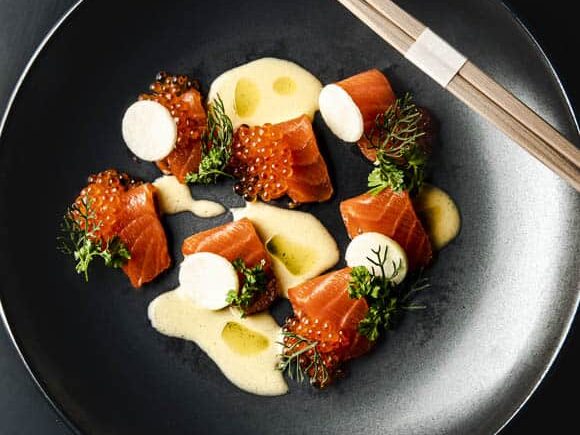Seafood 101:
What Is Sustainable Seafood?
In the age of climate change and ethical business practices, sustainability is a term popping up more often than ever. Today, industries throughout the nation are aiming for a more sustainable future, and the seafood industry is no exception.
In its simplest form, sustainability is the effort that a business or individual puts forth to limit their carbon footprint. Whether through business policies, regulations, or even the products they put out, businesses and individuals aim to do what is best for the environment, and these goals drive their actions.
When it comes to the seafood industry, sustainable seafood describes seafood that is harvested following rules, regulations, and best practices that don’t harm the environment or other wildlife. This intentional practice of sustainably harvested seafood applies to both wild-caught seafood and farm-raised seafood. When you tie in the element of sustainability, the details behind sustainable seafood are much more intentional than traditional commercial fisheries. Sustainable fisheries focus on promoting economic growth, delivering goods, and, most importantly, leaving as minimal a carbon footprint as possible on the environment they work in.
At Aqua Seafood & Caviar Restaurant, we are dedicated to making the world greener. Here, we only use sustainable seafood to ensure we do our part and help protect the environment.
For the best Seafood and More on the Vegas Strip, Come Join Us For Dinner today!
Sustainability drives today’s world
Since the dawn of capitalism, businesses have often led with a classical framework of profit over people. As the business world continued to evolve, sustainable companies ditched that traditional framework. Today, many industries, including the seafood sector, are focusing on sustainability and how they can leave the world a better place even after their business operations are done.
Today, we are going to explore the details of sustainable seafood and why it’s an essential factor to consider for your family. You may be surprised to find that the implications of sustainable seafood go far beyond what’s on the dinner table.
What is Aquaculture, and why is it important?
Seafood can sustainably be harvested from the wild directly, but more often, sustainable seafood drives aquaculture. Aquaculture is a regulated and highly controlled aquatic breeding, rearing, and harvesting facility.
These facilities are built into naturally occurring waterways and allow suppliers to produce seafood, including fish and shellfish, in a way that does not harm the environment or other aquatic species.
This controlled cultivation helps combat overfishing which eventually leads to the depopulation of species and the dissolution of ecosystems. Additionally, fisheries can produce the right amount of seafood needed for distribution.
The rise of aquaculture is a direct result of overfishing around the world. In an effort to preserve aquatic wildlife species, prevent overfishing, improve the environment, and satisfy the global demand for seafood, aquaculture was developed as a commercial alternative to wildlife fishing. Throughout the nation and in reputable international fisheries, strict guidelines direct the operation of the fisheries so that they meet the standards of sustainability.
While aquaculture exists in the United States, we are not a global leader in producing farm-raised seafood. Asia-Pacific, South Asia, and Europe account for over 70% of the globe’s aquaculture production, according to the International Trade Administration. While the United States still currently imports much of its seafood from international suppliers, the nation is continuing to grow towards a sustainable seafood industry through aquaculture.
Consider the Importance of Aquaculture
Aquaculture is important for several reasons. Aside from satisfying the global demand for seafood consumption, aquaculture is the necessary pillar for sustainable seafood. Aquaculture helps limit the industry’s carbon footprint in the following ways:
- Protecting aquatic wildlife by limiting overfishing
- Aquaculture results in fewer carbon emissions
- Economic growth for local communities
- Maintaining high standards, resulting in high-quality farm-raised seafood
- Producing high-quality, fresh catches for a healthy seafood diet.
Why is sustainable fishing important?
The practice of sustainable fishing, both in the wild and in aquaculture, has proved critical to helping fight climate change. But beyond its impact on the environment, sustainable fishing has proved impactful to local communities as well. When you purchase seafood and engage with companies that practice sustainable fishing, you are helping to promote industry practices that are designed to change the world for the better. Let’s take a look at two of the main critical outcomes of sustainable seafood.

Social Responsibility
Sustainable fishing helps promote safe, fair, and ethical working conditions for employees around the globe. Governing bodies of sustainable fishing companies imposed strict rules and guidelines so that fish are harvested ethically.
In the United States, the regulation under the Magnuson-Stevens Act is overseen by the National Marine Fisheries Service, a branch of the National Oceanic and Atmospheric Administration. In Europe, regulations are imposed under the Common Fisheries Policy, and managed by the European Commission.
As part of these regulations, workers are protected under strict labor laws that fight against human rights abuse. This includes the rejection of dangerous child labor, human trafficking, and forced labor. When you shop seafood that is sustainably sourced, you are helping to promote businesses that uphold their social responsibility for creating stronger communities through an ethically driven workforce.
Economic Growth for a Greener Future
Sustainable fishing also helps promote economic growth in local communities. For example, aquaculture facilities bring with them new jobs, better work conditions, and an economic boom that can support these local communities.
Additionally, the people who live in these communities have access to a locally grown food source. This access to healthy foods can help promote good eating habits, creating healthier community members.
With all the health benefits seafood—including salmon and tuna—can provide, this is one of the best ways to get your protein and essential vitamins and nutrients. If you’re wondering, is it bad to eat seafood every day, you’ll be glad to hear it’s not! Incorporating moderate amounts of varying seafood in your diet can help you get essential nutrients like Omega-3 fatty acids. To learn more, check out these types of seafood to include in your diet today!
What does ‘Sustainably Caught’ mean?
In a nutshell, seafood that is sustainably caught is seafood that is caught In a manner that does not do harm to the environment. Beyond this, sustainably caught seafood actually helps promote wildlife growth in ecosystems that would otherwise be collapsing due to overfishing.
In addition to this environmental influence, sustainable fisheries also adhere to strict laws and regulations pertaining to human rights.
As a consumer, it is easy to spot seafood products that adhere to these strict methods and standards. The next time you go to your local supermarket, keep an eye out for seafood that has a Marine Stewardship Council certification. This blue label is only issued to seafood brands that adhere to strict sustainability rules and regulations.
How You Can Do Your Part
Taking part in sustainable seafood is not as difficult as you might think. In fact, you might already be shopping for sustainable seafood without knowing it. By doing your part and participating in the sustainable seafood industry, you are helping to promote business practices that provide good to the environment, the communities that rely on seafood fisheries and aquaculture, and the globe as a whole. Here’s how you help promote a greener future.
Shop Sustainable Seafood
When you are shopping for seafood, look for packaging labels that indicate Marine Stewardship Council certification. These labels indicate that the seafood was harvested from fisheries that operate with sustainable business practices in mind.
Ask About Sustainable Seafood When Dining Out
One of the best ways to promote sustainable seafood practices is through societal pressure. After all, if the public doesn’t demand it, change will seldom come about. The next time you dine out, ask your favorite restaurant where they source their seafood. Understanding which of your favorite restaurants sustainably source their seafood allows you to make the best decision for you and your family.
Shop Local
Local fishermen operate on a very different business model than commercial fishermen. If you live in an area where you have access to local fishermen and fisheries, shopping from them can be an appropriate way to experience sustainable seafood.
Local, family-owned fishing operations typically do a much better job adhering to sustainability practices when catching wild seafood. Do your research to see if shopping locally can be an option for you.
The future of seafood is sustainable. Are you game?
At Aqua Seafood & Caviar Restaurant, we are proud to be a leader in Las Vegas, NV, for our appreciation and dedication to the sustainable seafood movement. Here, we only use sustainable seafood.
While caviar is our specialty, we take great pride in offering delectable seafood flavors that the locals and visitors of Las Vegas turn to time and time again. Visit us online to book your reservation and learn more about how we are committed to making the world a greener place.

Resources:
What is Aquaculture?. (2022).
International Trade Administration. (2022).
Magnuson-Stevens Act. (2017).
National Marine Fisheries Service.
Common Fisheries Policy. (2018).
